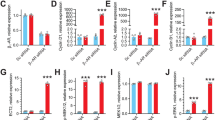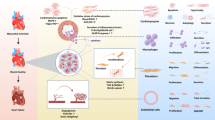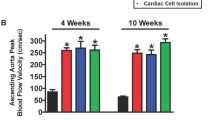Abstract
Ventricular remodeling after myocardial infarction is defined as progressive chamber dilation and wall thinning, which leads to functional compromise. Remodeling is mediated by active processes of inflammation, fibrosis, and cardiomyocyte dropout over the weeks and months after infarction, and, therefore, provides a large temporal therapeutic window. In experimental models, interruption of molecular and physiological pathways that contribute to cardiomyocyte loss, and the resulting unfavorable ventricular geometry, can abrogate remodeling and prevent or improve heart failure. Remodeling is multifactorial and involves several parallel cellular pathways, which means many potential therapeutic targets exist. Of late, much attention has been given to the development of cell-based therapies; however, the abundant, promising pharmacotherapeutic developments should not be overlooked. This Review examines developments in pharmacological treatment of ventricular remodeling in preclinical models of myocardial infarction—specifically, disruption of the renin–angiotensin–aldosterone system through direct renin inhibition and blockade of aldosterone synthesis and/or uptake, enhancement of endothelial nitric oxide synthase synthesis, G-protein receptor kinase inhibition, administration of erythropoietin, and interruption of apoptosis—and highlights the challenge of translating these successes to treatment of human disease. Therapeutic targeting of multiple organ systems involved in recovery after myocardial infarction might prove to be the best approach to improve patients' cardiac outcome.
Key Points
-
Ventricular remodeling is the most common reason for delayed heart failure after myocardial infarction
-
Remodeling involves ventricular wall thinning and chamber dilation that result from cardiomyocyte dropout and myocardial fibrosis
-
Diminished ventricular performance with postinfarction remodeling stimulates neurohormonal pathways that contribute to a vicious cycle of deterioration
-
Cycle interruption can be achieved by renin and/or aldosterone inhibition, enhancement of endothelial nitric oxide synthase synthesis, treatment with erythropoietin, restoration of β-adrenergic receptor–effector coupling, and inhibition of programmed death genes in preclinical models
-
Extracardiac interruption of the vicious cycle, as with aldosterone inhibition in the brain or G-protein receptor kinase inhibition in the adrenal gland, can be highly effective in preventing cardiac remodeling
This is a preview of subscription content, access via your institution
Access options
Subscribe to this journal
Receive 12 print issues and online access
$209.00 per year
only $17.42 per issue
Buy this article
- Purchase on Springer Link
- Instant access to full article PDF
Prices may be subject to local taxes which are calculated during checkout



Similar content being viewed by others
References
Yellon, D. M. & Hausenloy, D. J. Mycardial reperfusion injury. N. Engl. J. Med. 357, 1121–1135 (2007).
Pfeffer, M. A. & Braunwald, E. Ventricular remodeling after myocardial infarction. Experimental observations and clinical implications. Circulation 81, 1161–1172 (1990).
Kostuk, W. J., Kazamias, T. M., Gander, M. P., Simon, A. L. & Ross, J. Jr Left ventricular size after acute myocardial infarction. Serial changes and their prognostic significance. Circulation 47, 1174–1179 (1973).
Eaton, L. W., Weiss, J. L., Bulkley, B. H., Garrison, J. B. & Weisfeldt, M. L. Regional cardiac dilatation after acute myocardial infarction: recognition by two-dimensional echocardiography. N. Engl. J. Med. 300, 57–62 (1979).
De Angelis, N. et al. Appraisal of the role of angiotensin II and aldosterone in ventricular myocyte apoptosis in adult normotensive rat. J. Mol. Cell. Cardiol. 34, 1655–1665 (2002).
Sun, Y., Cleutjens, J. P., Diaz-Arias, A. A. & Weber, K. T. Cardiac angiotensin converting enzyme and myocardial fibrosis in the rat. Cardiovasc. Res. 28, 1423–1432 (1994).
Pfeffer, M. A., Pfeffer, J. M., Steinberg, C. & Finn, P. Survival after an experimental myocardial infarction: beneficial effects of long-term therapy with captopril. Circulation 72, 406–412 (1985).
Schieffer, B. et al. Comparative effects of chronic angiotensin-converting enzyme inhibition and angiotensin II type 1 receptor blockade on cardiac remodeling after myocardial infarction in the rat. Circulation 89, 2273–2282 (1994).
Wollert, K. C., Studer, R., von Bülow, B. & Drexler, H. Survival after myocardial infarction in the rat. Role of tissue angiotensin-converting enzyme inhibition. Circulation 90, 2457–2467 (1994).
Pfeffer, M. A. et al. Effect of captopril on mortality and morbidity in patients with left ventricular dysfunction after myocardial infarction. Results of the survival and ventricular enlargement trial. The SAVE Investigators. N. Engl. J. Med. 327, 669–677 (1992).
Køber, L. et al. A clinical trial of the angiotensin-converting-enzyme inhibitor trandolapril in patients with left ventricular dysfunction after myocardial infarction. Trandolapril Cardiac Evaluation (TRACE) Study Group. N. Engl. J. Med. 333, 1670–1676 (1995).
Pfeffer, M. A. et al. Valsartan, captopril, or both in myocardial infarction complicated by heart failure, left ventricular dysfunction, or both. N. Engl. J. Med. 349, 1893–1906 (2003).
Hunt, S. A. et al. ACC/AHA guidelines for the evaluation and management of chronic heart failure in the adult: executive summary. A report of the American College of Cardiology/American Heart Association Task Force on Practice Guidelines (Committee to revise the 1995 Guidelines for the Evaluation and Management of Heart Failure). J. Am. Coll. Cardiol. 38, 2102–2113 (2001).
Roig, E. et al. Clinical implications of increased plasma angiotensin II despite ACE inhibitor therapy in patients with congestive heart failure. Eur. Heart J. 21, 53–57 (2000).
Westermann, D., Schmieder, R., Schultheiss, H. P. & Tschöpe, C. Renin inhibitors, clinical experience. J. Mol. Med. 86, 691–695 (2008).
Westermann, D. et al. Renin inhibition improves cardiac function and remodeling after myocardial infarction independent of blood pressure. Hypertension 52, 1068–1075 (2008).
Feldman, D. L. et al. Effects of aliskiren on blood pressure, albuminuria, and (pro)renin receptor expression in diabetic TG(mRen-2)27 rats. Hypertension 52, 130–136 (2008).
Lombès, M. et al. Prerequisite for cardiac aldosterone action. Mineralocorticoid receptor and 11 beta-hydroxysteroid dehydrogenase in the human heart. Circulation 92, 175–182 (1995).
Silvestre, J. S. et al. Activation of cardiac aldosterone production in rat myocardial infarction: effect of angiotensin II receptor blockade and role in cardiac fibrosis. Circulation 99, 2694–2701 (1999).
Hayashi, M. et al. Relationship between transcardiac extraction of aldosterone and left ventricular remodeling in patients with first acute myocardial infarction: extracting aldosterone through the heart promotes ventricular remodeling after acute myocardial infarction. J. Am. Coll. Cardiol. 38, 1375–1382 (2001).
Robert, V. et al. Angiotensin AT1 receptor subtype as a cardiac target of aldosterone: role in aldosterone-salt-induced fibrosis. Hypertension 33, 981–986 (1999).
Xiao, F., Puddefoot, J. R., Barker, S. & Vinson, G. P. Mechanism for aldosterone potentiation of angiotensin II-stimulated rat arterial smooth muscle cell proliferation. Hypertension 44, 340–345 (2004).
Mazak, I. et al. Aldosterone potentiates angiotensin II-induced signaling in vascular smooth muscle cells. Circulation 109, 2792–2800 (2004).
Katada, J. et al. Persistent cardiac aldosterone synthesis in angiotensin II type 1A receptor-knockout mice after myocardial infarction. Circulation 111, 2157–2164 (2005).
Cohn, J. N. & Colucci, W. Cardiovascular effects of aldosterone and post-acute myocardial infarction pathophysiology. Am. J. Cardiol. 97, 4F–12F (2006).
Hayashi, M. et al. Immediate administration of mineralocorticoid receptor antagonist spironolactone prevents post-infarct left ventricular remodeling associated with suppression of a marker of myocardial collagen synthesis in patients with first anterior acute myocardial infarction. Circulation 107, 2559–2565 (2003).
Pitt, B. et al. Eplerenone Post-Acute Myocardial Infarction Heart Failure Efficacy and Survival Study Investigators. Eplerenone, a selective aldosterone blocker, in patients with left ventricular dysfunction after myocardial infarction. N. Engl. J. Med. 348, 1309–1321 (2003).
Pitt, B., Fonarow, G. C., Gheorghiade, M., Deedwania, P. C. & Duprez, D. A. Improving outcomes in post-acute myocardial infarction heart failure: incorporation of aldosterone blockade into combination therapy to optimize neurohormonal blockade. Am. J. Cardiol. 97, 26F–33F (2006).
Gomez-Sanchez, C. E. et al. Aldosterone biosynthesis in the rat brain. Endocrinology 138, 3369–3373 (1997).
Lal, A., Veinot, J. P. & Leenen, F. H. Critical role of CNS effects of aldosterone in cardiac remodeling post-myocardial infarction in rats. Cardiovasc. Res. 64, 437–447 (2004).
Zhu, G. Q. et al. AT1 receptor mRNA antisense normalizes enhanced cardiac sympathetic afferent reflex in rats with chronic heart failure. Am. J. Physiol. Heart. Circ. Physiol. 287, H1828–H1835 (2004).
Yu, Y. et al. Does aldosterone upregulate the brain renin-angiotensin system in rats with heart failure? Hypertension 51, 727–733 (2008).
Huang, B. S. et al. Central infusion of aldosterone synthase inhibitor attenuates left ventricular dysfunction and remodelling in rats after myocardial infarction. Cardiovasc. Res. doi:10.1093/cvr/cvn222 (2008).
Huang, B. S. & Leenen, F. H. Blockade of brain mineralocorticoid receptors or Na+ channels prevents sympathetic hyperactivity and improves cardiac function in rats post-MI. Am. J. Physiol. Heart Circ. Physiol. 288, H2491–H2497 (2005).
Huang, B. S., Ahmad, M., Tan, J. & Leenen, F. H. Sympathetic hyperactivity and cardiac dysfunction post-MI: different impact of specific CNS versus general AT1 receptor blockade. J. Mol. Cell. Cardiol. 43, 479–486 (2007).
Bauersachs, J. et al. Addition of spironolactone to angiotensin-converting enzyme inhibition in heart failure improves endothelial vasomotor dysfunction: role of vascular superoxide anion formation and endothelial nitric oxide synthase expression. J. Am. Coll. Cardiol. 39, 351–358 (2002).
Schäfer, A. et al. Addition of the selective aldosterone receptor antagonist eplerenone to ACE inhibition in heart failure: effect on endothelial dysfunction. Cardiovasc. Res. 58, 655–662 (2003).
Kubo, S. H., Rector, T. S., Bank, A. J., Williams, R. E. & Heifetz, S. M. Endothelium-dependent vasodilation is attenuated in patients with heart failure. Circulation 84, 1589–1596 (1991).
Scherrer-Crosbie, M. et al. Endothelial nitric oxide synthase limits left ventricular remodeling after myocardial infarction in mice. Circulation 104, 1286–1291 (2001).
Prabhu, S. D. Nitric oxide protects against pathological ventricular remodeling: reconsideration of the role of NO in the failing heart. Circ. Res. 94, 1155–1157 (2004).
Jones, S. P. et al. Endothelial nitric oxide synthase overexpression attenuates congestive heart failure in mice. Proc. Natl Acad. Sci. USA 100, 4891–4896 (2003).
Janssens, S. et al. Cardiomyocyte-specific overexpression of nitric oxide synthase 3 improves left ventricular performance and reduces compensatory hypertrophy after myocardial infarction. Circ. Res. 94, 1256–1262 (2004).
Sasaki, K. et al. Ex vivo pretreatment of bone marrow mononuclear cells with endothelial NO synthase enhancer AVE9488 enhances their functional activity for cell therapy. Proc. Natl Acad. Sci. USA 103, 14537–14541 (2006).
Fraccarollo, D. et al. Improvement in left ventricular remodeling by the endothelial nitric oxide synthase enhancer AVE9488 after experimental myocardial infarction. Circulation 118, 818–827 (2008).
Lefkowitz, R. J., Rockman, H. A. & Koch, W. J. Catecholamines, cardiac beta-adrenergic receptors, and heart failure. Circulation 101, 1634–1637 (2000).
Bristow, M. R. Beta-adrenergic receptor blockade in chronic heart failure. Circulation 101, 558–569 (2000).
Petrofski, J. A. & Koch, W. J. The beta-adrenergic receptor kinase in heart failure. J. Mol. Cell. Cardiol. 35, 1167–1174 (2003).
Ungerer, M., Böhm, M., Elce, J. S., Erdmann, E. & Lohse, M. J. Altered expression of beta-adrenergic receptor kinase and beta 1-adrenergic receptors in the failing human heart. Circulation 87, 454–463 (1993).
Vinge, L. E., Raake, P. W. & Koch, W. J. Gene therapy in heart failure. Circ. Res. 102, 1458–1470 (2008).
Rockman, H. A. et al. Expression of a beta-adrenergic receptor kinase 1 inhibitor prevents the development of myocardial failure in gene-targeted mice. Proc. Natl Acad. Sci. USA 95, 7000–7005 (1998).
Harding, V. B., Jones, L. R., Lefkowitz, R. J., Koch, W. J. & Rockman, H. A. Cardiac beta ARK1 inhibition prolongs survival and augments beta blocker therapy in a mouse model of severe heart failure. Proc. Natl Acad. Sci. USA 98, 5809–5814 (2001).
Freeman, K. et al. Alterations in cardiac adrenergic signaling and calcium cycling differentially affect the progression of cardiomyopathy. J. Clin. Invest. 107, 967–974 (2001).
White, D. C. et al. Preservation of myocardial beta-adrenergic receptor signaling delays the development of heart failure after myocardial infarction. Proc. Natl Acad. Sci. USA 97, 5428–5433 (2000).
Shah, A. S. et al. In vivo ventricular gene delivery of a beta-adrenergic receptor kinase inhibitor to the failing heart reverses cardiac dysfunction. Circulation 103, 1311–1316 (2001).
Rengo, G. et al. Myocardial adeno-associated virus serotype 6-betaARKct gene therapy improves cardiac function and normalizes the neurohormonal axis in chronic heart failure. Circulation 119, 89–98 (2009).
Williams, M. L. et al. Targeted beta-adrenergic receptor kinase (betaARK1) inhibition by gene transfer in failing human hearts. Circulation 109, 1590–1593 (2004).
Eckhart, A. D. & Koch, W. J. Expression of a beta-adrenergic receptor kinase inhibitor reverses dysfunction in failing cardiomyocytes. Mol. Ther. 5, 74–79 (2002).
Li, Z. et al. Effects of two Gbetagamma-binding proteins—N-terminally truncated phosducin and beta-adrenergic receptor kinase C terminus (betaARKct)—in heart failure. Gene Therapy 10, 1354–1361 (2003).
Raake, P. W. et al. G protein-coupled receptor kinase 2 ablation in cardiac myocytes before or after myocardial infarction prevents heart failure. Circ. Res. 103, 413–422 (2008).
Lymperopoulos, A., Rengo, G., Funakoshi, H., Eckhart, A. D. & Koch, W. J. Adrenal GRK2 upregulation mediates sympathetic overdrive in heart failure. Nat. Med. 13, 315–323 (2007).
Ghezzi, P. & Brines, M. Erythropoietin as an antiapoptotic, tissue-protective cytokine. Cell Death Differ. 11, S37–S44 (2004).
Diwan, A. et al. Unrestrained erythroblast development in Nix−/− mice reveals a mechanism for apoptotic modulation of erythropoiesis. Proc. Natl Acad. Sci. USA 104, 6794–6799 (2007).
Joyeux-Faure, M. Cellular protection by erythropoietin: new therapeutic implications? J. Pharmacol. Exp. Ther. 323, 759–762 (2007).
Calvillo, L. et al. Recombinant human erythropoietin protects the myocardium from ischemia–reperfusion injury and promotes beneficial remodeling. Proc. Natl Acad. Sci. USA 100, 4802–4806 (2003).
Moon, C. et al. Erythropoietin reduces myocardial infarction and left ventricular functional decline after coronary artery ligation in rats. Proc. Natl Acad. Sci. USA 100, 11612–11617 (2003).
Parsa, C. J. et al. A novel protective effect of erythropoietin in the infarcted heart. J. Clin. Invest. 112, 999–1007 (2003).
Riksen, N. P., Hausenloy, D. J. & Yellon, D. M. Erythropoietin: ready for prime-time cardioprotection. Trends Pharmacol. Sci. 29, 258–267 (2008).
Liu, X. et al. Mechanism of the cardioprotection of rhEPO pretreatment on suppressing the inflammatory response in ischemia–reperfusion. Life Sci. 78, 2255–2264 (2006).
van der Meer, P. et al. Erythropoietin induces neovascularization and improves cardiac function in rats with heart failure after myocardial infarction. J. Am. Coll. Cardiol. 46, 125–133 (2005).
Cai, Z. et al. Hearts from rodents exposed to intermittent hypoxia or erythropoietin are protected against ischemia–reperfusion injury. Circulation 108, 79–85 (2003).
Lipsic, E. et al. A single bolus of a long-acting erythropoietin analogue darbepoetin alfa in patients with acute myocardial infarction: a randomized feasibility and safety study. Cardiovasc. Drugs Ther. 20, 135–141 (2006).
Liem, A. et al. Effect of EPO administration on myocardial infarct size in patients with non-STE acute coronary syndromes; results from a pilot study. Int. J. Cardiol. 131, 285–287 (2009).
Ponikowski, P. et al. Effect of darbepoetin alfa on exercise tolerance in anemic patients with symptomatic chronic heart failure: a randomized, double-blind, placebo-controlled trial. J. Am. Coll. Cardiol. 49, 753–762 (2007).
van Veldhuisen, D. J. et al. Randomized, double-blind, placebo-controlled study to evalute the effect of two dosing regimens of darbepoetin alfa in patients with heart failure and anaemia. Eur. Heart J. 28, 2208–2216 (2007).
Ghali, J. K. et al. Randomized double-blind trial of darbepoetin alfa in patients with symptomatic heart failure and anemia. Circulation 117, 526–535 (2008).
Kobayashi, H. et al. Post-infarct treatment with an erythropoietin-gelatin hydrogel drug delivery system for cardiac repair. Cardiovasc. Res. 79, 611–620 (2008).
Dorn, G. W. 2nd Apoptotic and non-apoptotic programmed cardiomyocyte death in ventricular remodelling. Cardiovasc. Res. doi:10.1093/cvr/cvn243 (2008).
Yussman, M. G. et al. Mitochondrial death protein Nix is induced in cardiac hypertrophy and triggers apoptotic cardiomyopathy. Nat. Med. 8, 725–730 (2002).
Diwan, A. et al. Nix-mediated apoptosis links myocardial fibrosis, cardiac remodeling, and hypertrophy decompensation. Circulation 117, 396–404 (2008).
Diwan, A. et al. Inhibition of ischemic cardiomyocyte apoptosis through targeted ablation of Bnip3 restrains postinfarction remodeling in mice. J. Clin. Invest. 117, 2825–2833 (2007).
Javadov, S. & Karmazyn, M. Mitochondrial permeability transition pore opening as an endpoint to initiate cell death and as a putative target for cardioprotection. Cell Physiol. Biochem. 20, 1–22 (2007).
Diwan, A. et al. Endoplasmic reticulum–mitochondria crosstalk in Nix-mediated murine cell death. J. Clin. Invest. 119, 203–212 (2009).
Author information
Authors and Affiliations
Corresponding author
Ethics declarations
Competing interests
The author declares no competing financial interests.
Rights and permissions
About this article
Cite this article
Dorn, G. Novel pharmacotherapies to abrogate postinfarction ventricular remodeling. Nat Rev Cardiol 6, 283–291 (2009). https://doi.org/10.1038/nrcardio.2009.12
Issue Date:
DOI: https://doi.org/10.1038/nrcardio.2009.12
This article is cited by
-
Definition of left ventricular remodelling following ST-elevation myocardial infarction: a systematic review of cardiac magnetic resonance studies in the past decade
Heart Failure Reviews (2022)
-
Reverse Cardiac Remodeling and ARNI Therapy
Current Heart Failure Reports (2021)
-
Serum neprilysin levels are associated with myocardial stunning after ST-elevation myocardial infarction
BMC Cardiovascular Disorders (2020)
-
Effect of miR-26a-5p targeting ADAM17 gene on apoptosis, inflammatory factors and oxidative stress response of myocardial cells in hypoxic model
Journal of Bioenergetics and Biomembranes (2020)
-
Cell death pathologies: targeting death pathways and the immune system for cancer therapy
Genes & Immunity (2019)



